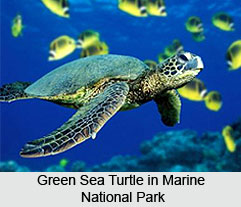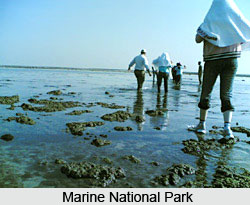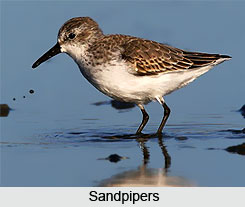 Marine National Park is located in the Indian state of Gujarat. More specifically, this national park is situated on the southern shore of the Gulf of Kutch in the district of Jamnagar. The Gulf of Kutch is situated on the west coast of India. It separates the Saurashtra Peninsula from the Great and Little Rann of Kutch. At its seaward (western) end, the Gulf of Kutch is about 58 km wide and from this point it tapers gradually eastwards, extending for nearly 170 km with a maximum depth of about 60 meters and an average depth of about 20 meters. Marine National Park is credited with the status of being India`s first Marine Sanctuary and National park of India.
Marine National Park is located in the Indian state of Gujarat. More specifically, this national park is situated on the southern shore of the Gulf of Kutch in the district of Jamnagar. The Gulf of Kutch is situated on the west coast of India. It separates the Saurashtra Peninsula from the Great and Little Rann of Kutch. At its seaward (western) end, the Gulf of Kutch is about 58 km wide and from this point it tapers gradually eastwards, extending for nearly 170 km with a maximum depth of about 60 meters and an average depth of about 20 meters. Marine National Park is credited with the status of being India`s first Marine Sanctuary and National park of India.
History of Marine Sanctuary and National Park
Under the provisions of the Wildlife Protection Act, Marine Sanctuary was established in the year 1980, whereas Marine National Park was established in the year1982. They were established with the aim to shelter and preserve the threatened marine flora and fauna of the area.
Geography of Marine Sanctuary and National Park
At the time of establishment, the Marine Sanctuary was spread over an area of about 270 square kilometers, more specifically from Okha to Jodhya. It had a core area of about 110 square kilometers, which was later notified as the Marine Park. About 7,000 ha off Okha in the west and about 4,000 ha off Jamnagar in the east thus came under the Marine National Park. In the year1982, there was an expansion in the area of the sanctuary from 270 square kilometers to nearly 458 square kilometers, whereas the Marine National Park after expansion comprised an area of about 162.89 square kilometers. The protected area of Marine National Park is adorned by a geographical feature called archipelago. An archipelago is defined as an extensive group of islands. Marine National Park also has an extensive group of about 42 islands on the Jamnagar coast, in the Gulf of Kutch. 
Wildlife of Marine Sanctuary and National Park
Marine National Park is known to be stocked with a rich species of wild life. As per estimations,
it shelters more than 200 species of molluscs, 150-200 species of fishes, about 108 species of brown, green and red algae, about 94 species of water birds, about 78 species of terrestrial birds, about 70 species of sponges, about 37 species of hard and soft corals, about 30 species of crabs, about 27 species of prawns, about 3 species of sea snakes, about 3 species of endangered sea turtles and about 3 species of sea mammals.
Flora of Marine Sanctuary and National Park
Marine National Park is a home to mangroves. These mangroves cover a large area of the park. As per estimations, about 6 species of mangroves have been recorded in the park area. They are the Avicennia Marina, the Avicennia Alba, the Avicennia Officianalis, the Rhizophora Mucronata, the Ceriops Tagal and the Aegiceros Corniculata. Species like the Salvadora, the Tamarix Dioca and the Commiphora Wightii have also been witnessed on the islands. The mangrove marshes are characteristically slushy and muddy. They serve as a home to marine creatures, marine flora and colorful living corals. These mangroves are also holding the huge breeding colonies of painted stork, ducks, avocets, herons, terns, spoonbills, egrets, ibises and darters. Apart from mangroves, some of the other floral species of the park are Saag, Sea Grass, Kheru and Sea Weeds.
 Sea grasses not only serve as a home to the diverse biota, but also functions as buffers between mangroves and corals. Unique faunal species are dependent on some of the sea grass species. They are the migratory sea turtles, endangered herbivorous marine mammal dugong and the sea horse. The coast of Gulf of Kutch and the sea shore of Saurashtra serve as the breeding places for green turtles. They travel all the way from Brazil for the said purpose. Other faunal species utilizing the Gulf of Kutch are the green sea turtles, olive ridley turtles and leather back turtles. The Marine National Park possesses a hatchery at Madhupur near Porbandar and also has some temporary hatcheries on islands near Okha and Dwarka.
Sea grasses not only serve as a home to the diverse biota, but also functions as buffers between mangroves and corals. Unique faunal species are dependent on some of the sea grass species. They are the migratory sea turtles, endangered herbivorous marine mammal dugong and the sea horse. The coast of Gulf of Kutch and the sea shore of Saurashtra serve as the breeding places for green turtles. They travel all the way from Brazil for the said purpose. Other faunal species utilizing the Gulf of Kutch are the green sea turtles, olive ridley turtles and leather back turtles. The Marine National Park possesses a hatchery at Madhupur near Porbandar and also has some temporary hatcheries on islands near Okha and Dwarka.
Fauna of Marine Sanctuary and National Park
The primary population of the Marine National Park is that of corals. This park has a rich collection of corals and a complex coral reef ecosystem is known to exist here. They will be evident to the tourists in different shapes and sizes. This national park serves as a home to coral lichens, coral sponges, green sponges, jelly fishes, starfishes, puffer fishes, octopuses, dugongs, gangetic dolphins, jackals, crabs and prawns. Reptiles are also housed in the park namely, common monitors, green sea-turtles and leatherback turtles.
Avifauna of Marine Sanctuary and National Park
Marine National Park is also diverse in terms of bird species. Some of them are imperial eagle, pallid harrier, common kestrel, variable wheatear, Indian courser and laggar falcon. An estimated of more than 30 different species of migratory birds come to this park and stay in the mangrove forests, during the months of monsoons.
Other Places of Attraction around Marine Sanctuary and National Park
Khijadiya and Dwarikadish Temple are known to be the other places of attraction around the Marine National Park. Khijadiya is a bird sanctuary and is located at a distance of about 15 kilometers from Jamnagar. It houses resident and as well as migratory birds in abundance and will therefore serve as a haunt for the bird lovers. The Dwarkadhish temple, also known as the Jagat Mandir is a Hindu temple. The ruling deity of the temple is Lord Krishna. He is known by the name of Dwarkadhish (meaning the King of Dwarka in English) to the devotees of the temple. This temple is held sacred by the Hindus and is religiously significant to them as it is an important part of their Char Dham Yatra (also known as pilgrimage in English). This temple is a part of the yatra as Adi Shankaracharya, an unprecedented philosopher and savant of Bharat, had visited this shrine.
Visiting Information
The time period between October and March is generally considered to be the best time to plan a tour to Marine National Park. Jamnagar, located at a distance of about 7km is the nearest town to Marine National Park.
Related Articles:
Indian National Parks
Indian Wildlife Sanctuaries
Indian Flora and Fauna
Indian Wildlife
Bird Sanctuaries in India
Indian Biosphere Reserves











